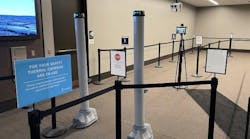WASHINGTON -- Homeland Security Secretary Janet Napolitano endorsed the use of body scanners Wednesday to screen airline passengers despite concerns that the machines create vivid images of people under their clothing.
Napolitano told the House Homeland Security Committee that body scanners are "actually less intrusive and easier" than being patted down by an airport screener.
Last week, Tulsa International Airport became the first airport to use a body-scanning machine in place of a metal detector, which has been the main device to search airline passengers since screening began in 1973. The Transportation Security Administration plans to use the scanners in place of some metal detectors at five other airports, including San Francisco, Miami and Las Vegas, saying the machines detect plastic and liquid explosives that evade metal detectors.
Napolitano's support came after Rep. Dan Lungren, R-Calif., suggested addressing privacy concerns by creating an "I-don't-care line" at airport checkpoints for travelers such as himself who don't mind the scanners.
"I'm serious about this," Lungren said as the hearing-room crowd broke into laughter. "I think if you had an I-don't-care line, many of us would rather go through that. Some of the privacy issues that might bubble up would be alleviated."
"We actually have an I-care-deeply line," Napolitano replied, saying that passengers who don't want to go through a body scanner can opt to walk through a metal detector. Napolitano said that the technology "seems to be very promising at the least," and that the main issue for the machines "is going to be, can we make it more rapid so we don't have lines at airports."
The American Civil Liberties Union says the machines provide "a virtual strip-search" and deploying them in airports could lead to their use at train stations, arenas and office buildings.
Passengers step into the 9-foot-tall glass-walled machines that bounce harmless millimeter waves off people to create a metallic-looking image that airport screeners view on a monitor in a closed room. Faces are blurred, and the images are deleted as soon as a passenger is cleared through a checkpoint. The process takes a little longer than metal-detector screening.
Napolitano told lawmakers it "will be difficult if not impossible" to meet a 2012 deadline Congress set in 2006 to screen all shipping containers in overseas ports for nuclear and radiological materials. The department has to negotiate agreements with foreign ports to install detectors to screen the 11 million containers that come into the U.S. ports each year.
Napolitano's predecessor, Michael Chertoff, also had said the 2012 deadline would not be met.


